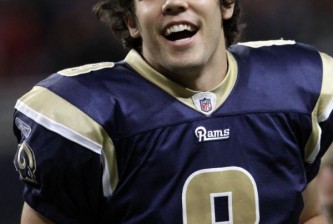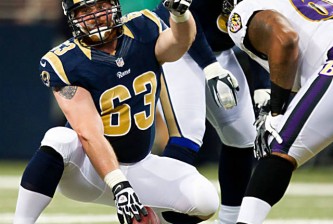
The NFL Draft Wizard Twitter Experts 7-round Mock Draft (how’s that for a name?) kicked off with a bang today, as the St Louis Rams and Cleveland Browns pulled off a deal to deliver Robert Griffin III into Pat Shurmur’s hot little hands. The particulars:
Cleveland, GMed by Jesse Aubin (@nefinfan), sends the #4, #22, and #37 picks to the Rams in exchange for their #2 overall pick. More on the deal in a moment, but first, here’s how the first four picks shook out:
- Colts (@EugeneStasakJr) select QB Andrew Luck
- Browns (@nefinfan) select QB Robert Griffin III
- Vikings (@Lundar71) select OT Matt Kalil
No surprises so far, I think you’ll agree. But the fourth pick presented a realm of possibilities for the Rams: notably, go for the best player available, or the best offensive player available? While a number of players intrigued from a skill position standpoint, ultimately I believe the Jeff Fisher / Les Snead approach to rebuilding is not going to be swayed by “need” the way the fans feel it.
Fisher and Snead inherit a team woefully bereft of “blue” players, the draftnik designation given to elite athletes who also happen to be damn good football players. Their number one mission in this draft and the next (and the next, and the next) has to be the acquisition of more of these types of players, regardless of the position they play.
The Pick
They need to get bigger off the bus, faster, stronger, more physical, and more able to make individual plays that can move the momentum of a game. LSU cornerback Morris Claiborne may not be a monster, he fits the profile and adds ball skills that help push him over the top.
While Claiborne has hands you would expect from a player who originally came to LSU as a wide receiver, it’s his agility that puts him in position to make so many game-changing plays:
One of the reasons Claiborne plays the deep ball so well is that he’s adept at flipping his hips. The fluidity he displays from his backpedal to a turn-and-run position is outstanding. Claiborne’s quick hips allow him to let receivers eat up his cushion before he turns to run if they go deep. In turn, Claiborne can then squat on routes like comebacks and curls, knowing he has the quickness to recover if the receiver reaches his hip.
This skill, which feeds anticipation, “instincts,” and everything else that allows a cornerback to play fast, is so much more important than a fast time in the 40 yard dash. The Rams have had burners before – Tye Hill and Justin King both ran 4.31 times in the NFL Combine – but they have not had a true shutdown player for as long as I can remember. (As old as I am, that window is getting shorter.)
Rams fans hungry for a wide receiver have already made their concerns known via Twitter, but I believe that there is plenty of impact offensive talent that will be available the next time we come up to pick. However, I will acknowledge that this is a risky strategy.
In doing draft research last year, I discovered that the risk of drafting a bust WR is pretty much the same among the first four receivers that go off the board. But your chances of drafting a stud drop starkly after the first two are gone. However, if you aren’t convinced of a player’s “elite” status, and I am not convinced about very-good-but-not-elite players like Justin Blackmon, Kendall Wight or Michael Floyd, you shouldn’t be picking them in the top 5. Getting a “very good” player later in the draft is perfectly fine with me, and will still improve our wideout corps.
The Deal
Getting three picks in the top 40 is a strong deal, any way you slice it. But it falls short of the “three-number-ones” king’s ransom being bandied about in the media. However, a couple of factors kept us from pursuing the full leverage that we might have in this mock.
#1: We aren’t beholden to act like the teams we root for. While I am doing my best to approximate Snead and Fisher’s approach (because I believe in it), the GM for the Redskins is an avid proponent of trading down and collecting picks, regardless of team need or of his team’s desperation to land RG3. I knew this about Josh from last year’s MockOne draft process, and was not surprised when he rebuffed my offer to trade up.
#2: Everyone is talking to everyone else. We’re a social bunch, we Twitterers, and once one GM started sending out mass emails talking about their intentions to trade down, all kinds of folks chimed in. Including Josh, which could have threatened to erase any leverage I had in the deal. Fortunately, I had already come to agreement with Jesse before the reply-all’s started circulating.
#3: We decided that no 2013 draft picks can be included in deals. This is both good and bad, good because I think it holds us to a more realistic standard. It’s much easier for a Twitter GM to sacrifice something they don’t actually have, than to give up a pick that they themselves will be making this weekend. So opening that door might lead to draft-deal shenanigans that would never happen in the real world. But closing that door also closes the door on the possibilities of pulling off a blockbuster with a team like Washington or Miami, or from maximizing the return from Cleveland.
A side note: I actually opened the door to trading down one more spot, with the GM of the Tampa Bay Buccaneers, knowing that they might be strongly interested in Claiborne. But his lack of a 4th round pick (100 critical draft points that could have neatly filled the gap between #4 and #5 overall) made my offer more complex.
Ultimately, I’ll never know if we could have come to a deal, because I didn’t give it a lot of time to ripen before deciding to pull the trigger on Claiborne. And with a top-tier prospect coming to the Rams, I have no regrets.






















